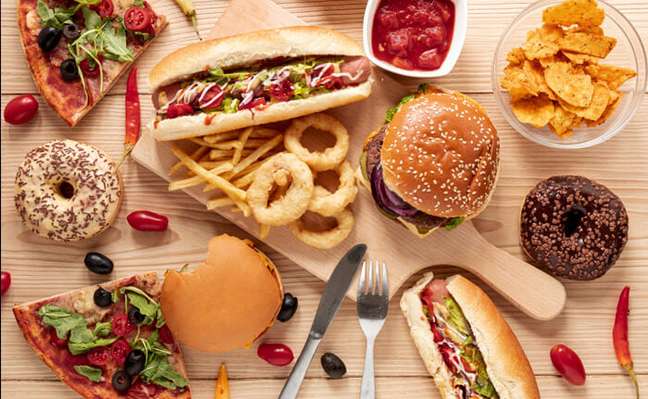Consumption of ultra-processed foods grows during the crisis and Brazil is experiencing an obesity epidemic

If in the distant past obesity was associated with the abundance and richness of food, in the next few years it will have a very different face. The financial crisis is leading Brazilians to consume more and more unhealthy foods.
A survey conducted by Fiocruz during the pandemic indicated a 4.3% drop in vegetable consumption and the consumption of snacks, chocolates and other ultra-processed foods increases between 3.7% and 5.8%.
The University of Sao Paulo’s Center for Epidemiological Research in Nutrition and Health (Nupens / USP) found that, since the start of the economic crisis, this increase has occurred among the poorest 60%.
“Brazilians are getting poorer and poorer. the consumption of nutrient-rich foods is decreasing in proportion to the increase in processed products. These types of foods do not provide fiber, vitamins, minerals and phytochemicals, but have a high amount of calories, sugars, fats and chemical elements which, if consumed in excess, unbalance the functioning of the organism, increasing the work of the immune system. and damaging the performance of the central nervous system ”, explains the functional nutritionist Diogo Cirico, technical manager of Growth Supplements.
Understand why ultra-processed foods are so bad
Historically, food has always been cheaper in nature, but the price difference to ultra-processed foods has been decreasing over the years. A study from the Federal University of Minas Gerais (UFMG) estimates that, in 2026, it will be cheaper to eat sausages, instant noodles and frozen processed foods, such as nuggets, pizzas and lasagna. And this, says the nutritionist, is bad news for health.
“We are already experiencing an epidemic of obesity, metabolic and cardiovascular diseases“, The projection for the next 10 years is even worse”. believes Cirico.
Explain that this type of food is particularly dangerous because it contains chemical additives and preservatives; potentially carcinogenic substances; saturated fats; high amounts of sugar and salt, as well as so-called flavor enhancers, which can work by encouraging the person to eat more.
“Our central nervous system has mechanisms to regulate when we are hungry and when we are full. Flavor enhancers can throw these mechanisms off balance and, instead of feeling full and stop eating, the individual continues to eat, ”she says.
Differences to be considered
The nutritionist says, however, that it is possible to have a more nutritious, but still economical, diet. Then, he checks the differences between the ultra-processed versions and the healthier foods.
• Instant Pasta X Spaghetti Noodles
The instant version has 10 times more fat and half of that fat is saturated. Not to mention the ready-made dressing in instant noodles, rich in sodium and all kinds of preservatives.
• Soda X natural fruit juice
Juice has carbohydrate calories, it also has vitamins, phytochemicals and minerals, and soda only has carbohydrate calories. When a food provides only calories, without nutrients, it has a ‘parasitic’ behavior, that is, it consumes nutrient reserves during the metabolic process.
• Filled Biscuit X Simple Biscuit
Non-filled cookies can be eaten even if they are not high in nutrients, while filled cookies contain sugar, trans fat, saturated fat, sodium and a large amount of synthetic additives. Excessive consumption of these ingredients leads to an increase in various diseases, including cardiovascular diseases.
• Nuggets X Chicken the Bird
Croquettes are a mixture of meat with flour, flavor enhancer and hydrogenated fat, to be avoided at all costs due to the high amount of damage it can lead to health. While bird chicken can only be prepared with natural toppings and without the skin, further reducing the fat content of the preparation.
• Ham, sausages, turkey breast X grilled chicken breast
Sausages have high concentrations of saturated fat and bring a highly harmful compound: the nitrites used for preservation can be converted into nitrosamines and their excessive consumption is associated with an increase in the incidence of cancer. Chopped chicken breast seasoned with natural products can be a good substitute for making sandwiches. You can make a larger batch and freeze it in small portions for use during the week.
• Frozen ready meals (burgers, lasagna, pizza) X homemade dishes
There is nothing wrong with occasionally eating pizza, burgers, or lasagna. Problems start when the entire diet is low in nutrients, when the total calorie intake is excessive, and when these foods are made with low nutritional value ingredients. When making burgers at home, we can use lean meats, add vegetables such as lettuce, tomato and cucumber to taste. In the case of pizzas we can use wholemeal flour, add natural toppings, use low-fat cheeses and lean proteins.
• Ice creams X Homemade desserts such as fruit jam
The great harm of ice cream is the presence of trans / saturated fats (especially in those products of lower quality and price), sugar and other chemical additives. The more synthetic ingredients we have, the greater the damage can be.
• Ready-made sauces X homemade sauces
There are a multitude of recipes featuring natural low-fat yogurt, olive oil, lemon, and natural dressings and toppings. Although equivalent in calories, they will be more suitable than ready-made sauces, which have the presence of synthetic food additives.
• Instant dressing X natural dressing
In addition to having excess sodium, some ready-made toppings have flavor enhancers, which can lead to people eating out of control. Substitute condiments made from garlic, onions, parsley, chives, and other herbs.
• Natural Popcorn Chips X
The snacks have dyes, flavors, acidifiers and flavor enhancers that “adapt” the taste. Popcorn when made on the stove with oil is a snack source of carbohydrates, fiber, and phytochemicals. Warning: microwave popcorn contains additives such as diacetyl, one of the most dangerous.
.
Source: Terra
Benjamin Smith is a fashion journalist and author at Gossipify, known for his coverage of the latest fashion trends and industry insights. He writes about clothing, shoes, accessories, and runway shows, providing in-depth analysis and unique perspectives. He’s respected for his ability to spot emerging designers and trends, and for providing practical fashion advice to readers.





![Un Si Grand Soleil Preview: Episode Summary for Tuesday, October 21, 2025 [SPOILERS] Un Si Grand Soleil Preview: Episode Summary for Tuesday, October 21, 2025 [SPOILERS]](https://fr.web.img4.acsta.net/img/c7/7f/c77f5c02e3632e8e611d5041c2b9f36e.jpg)

